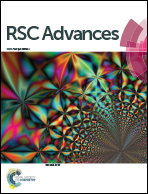Preparation and properties of carbon nanotube/carbon fiber hybrid reinforcement by a two-step aryl diazonium reaction
Abstract
Raw carbon nanotube (CNT)/carbon fiber (CF) hybrids were achieved through a two-step aryl diazonium reaction in mild, eco-friendly conditions. Raman spectra, Fourier transform infrared spectroscopy (FT-IR) and X-ray photoelectron spectroscopy (XPS) confirmed the grafting of CNT onto the CF surface. The surface topography and surface free energy of the modified CFs were examined by scanning electron microscopy (SEM), transmission electron microscope (TEM) and dynamic contact angle (DCA) tests, respectively. The resulting CNT/CF hybrid formed a strong chemical bond between the fiber and matrix and enhanced the surface wettability of the modified CFs. The interfacial shear strength (IFSS) of the CNT/CF hybrid reinforced composites increased by 104% compared with that of the untreated CFs. Moreover, the mechanical properties of the CNT/CF hybrid showed a slight improvement after modification.


 Please wait while we load your content...
Please wait while we load your content...